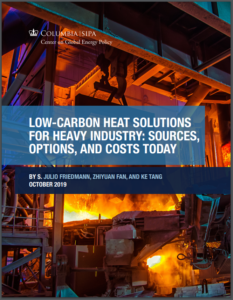Full Title: Low-Carbon Heat Solutions for Heavy Industry: Sources, Options, and Costs Today
Author(s): DR. JULIO FRIEDMANN, ZHIYUAN FAN, AND KE TANG
Publisher(s): Center on Global Energy Policy at Columbia University
Publication Date: October 7, 2019
Full Text: Download Resource
Description (excerpt):
Recent studies indicate there is an urgent need to dramatically reduce the greenhouse gas emissions from heavy industrial applications (including cement, steel, petrochemicals, glass and ceramics, and refining). Heavy industry produces roughly 22 percent of global CO₂ emissions. Of these, roughly 40 percent (about 10 percent of total emissions) is the direct consequence of combustion to produce high-quality heat, almost entirely from the combustion of fossil fuels. This is chiefly because these fuels are relatively cheap, are widely available in large volumes, and produce high-temperature heat in great amounts.
Many industrial processes require very large amounts of thermal energy at very high temperatures (more than 300°C and often more than 800°C). For example, conventional steel blast furnaces operate at about 1,100°C, and conventional cement kilns operate at about 1,400°C. In addition, many commercial industrial facilities require continuous operation or operation on demand. The nature of industrial markets creates challenges to the decarbonization of industrial heat. In some cases (e.g., steel, petrochemicals), global commodity markets govern product trade and price. Individual national action on the decarbonization of heavy industry can lead to trade disadvantage, which can be made acute for foundational domestic industries (in some cases, with national security implications). This can also lead to offshoring of production and assets, leading to carbon “leakage” as well as local job and revenue loss (with political consequences). In many cases, lack of options could lead to dramatic price increases for essential products (e.g., cement for concrete, an essential building material). Risk of carbon leakage, price escalation, and trade complexity limits the range of policy applications available to address this decarbonization need.
